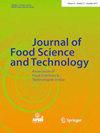木薯、大米、大豆复合粉复合蛋白粉的生产与评价
IF 3.3
3区 农林科学
Q2 FOOD SCIENCE & TECHNOLOGY
引用次数: 2
摘要
以木薯粉、米粉和豆粉为原料,进行复合面粉的生产和评价研究。将米粉、木薯粉和豆粉按30:40:30、30:50:20、30:60:10和30:70:0的比例混合制成4种复合面粉,分别标记为T1、T2、T3和T4。对所生产的复合面粉进行了近似性能、矿物性能、糊状性能、功能性能、感官评价和氰化氢测定等方面的分析。复合材料的水分、蛋白质、灰分、脂肪、粗纤维和碳水化合物含量分别为11.57 ~ 12.40%、1.37 ~ 13.17%、0.37 ~ 0.74%、0.12 ~ 0.34%、3.23 ~ 3.65%和70.48 ~ 82.37%。复合材料在conc/ppm中的镁、铁、钙和磷含量分别为184.67221.33、9.033-10.03、216.33-544.66和0.167-3543.67,而锌未检出。4种复合面粉的pH、容重、溶胀力、溶解度指数、吸水能力、吸油能力和可吸附性均无显著差异(P > 0.05)。峰1、谷1、击穿、终粘度、退峰、峰时间和膏体温度分别为737.00 ~ 1818.00 cP、661.00 ~ 1369.00 cP、62.00 ~ 449.00 cP、868.00 ~ 1894.00 cP、207.00 ~ 525.00 cP、4.73 ~ 4.93 min和75.85 ~ 77.65 C。在访问的所有属性上没有显著差异(P < 0.05),尽管样本T2是最普遍接受的,但样本总体上被小组成员接受。样本的氰化氢含量为3.42至3.60毫克/公斤,与联合国粮农组织建议的标准致死剂量(10毫克/公斤)相比是非常安全的。综上所述,大米、木薯和大豆粉组成的复合面粉具有良好的理化性能和功能特性,适合制作浓缩粉,其中含有30%米粉、50%木薯粉和20%大豆粉的样品T2是最被普遍接受的。本文章由计算机程序翻译,如有差异,请以英文原文为准。
Production and Evaluation of a Protein-Enriched Meal from Composite Flour of Cassava, Rice and Soybean
The study aimed at production and evaluation of composite flour produced from cassava, rice and soybean flours. Four blends of composite flours were prepared by mixing rice flour, cassava flour and soybean flour in the proportions of 30:40:30, 30:50:20, 30:60:10 and 30:70:0 and labelled T1, T2, T3 and T4 respectively. Composite flours produced were analyzed for proximate, mineral, pasting and functional properties, sensory evaluation and hydrogen cyanide determination. The moisture content, protein, ash, fat, crude fiber and carbohydrate of the composites ranged from 11.57-12.40% dry bases, 1.37-13.17%, 0.37-0.74%, 0.12-0.34%, 3.23-3.65% and 70.48-82.37% respectively. The magnesium, iron, calcium and phosphorus of the composites in conc/ppm ranged from 184.67221.33, 9.033-10.03, 216.33-544.66 and 0.167-3543.67 respectively while zinc was not detected. There was no significant difference (P > 0.05) recorded for pH, bulk density, swelling power, solubility index, water absorption capacity, oil absorption capacity and dispensability of the four blends of composite flour. The ranges of Peak 1, trough 1, breakdown, final viscosity, set back, peak time and pasting temperature are 737.00-1818.00 cP, 661.001369.00 cP, 62.00-449.00 cP, 868.00-1894.00 cP, 207.00-525.00 cP, 4.73-4.93 min and 75.85-77.65 C respectively. There is no significant difference in all the attributes that were accessed at (P < 0.05) and the samples were generally acceptable by the panelists although sample T2 was the most generally accepted. The hydrogen cyanide content of the samples ranged from 3.42 to 3.60 mg/kg which is very safe when compared with standard lethal dose (10 mg/kg) recommended by Food and Agricultural Organization (FAO). Hence, it was concluded that the composite flours from rice, cassava, and soybean flour had the physicochemical and functional properties which is suitable for making an enriched meal and sample T2 containing 30% Rice Flour, 50% Cassava Flour and20% Soybean flour was the most generally accepted.
求助全文
通过发布文献求助,成功后即可免费获取论文全文。
去求助
来源期刊
CiteScore
7.70
自引率
0.00%
发文量
274
审稿时长
11 months
期刊介绍:
The Journal of Food Science and Technology (JFST) is the official publication of the Association of Food Scientists and Technologists of India (AFSTI). This monthly publishes peer-reviewed research papers and reviews in all branches of science, technology, packaging and engineering of foods and food products. Special emphasis is given to fundamental and applied research findings that have potential for enhancing product quality, extend shelf life of fresh and processed food products and improve process efficiency. Critical reviews on new perspectives in food handling and processing, innovative and emerging technologies and trends and future research in food products and food industry byproducts are also welcome. The journal also publishes book reviews relevant to all aspects of food science, technology and engineering.

 求助内容:
求助内容: 应助结果提醒方式:
应助结果提醒方式:


